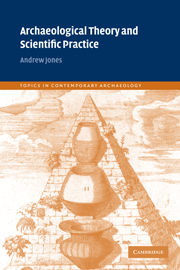Book contents
- Frontmatter
- Contents
- List of illustrations
- List of tables
- Preface
- Acknowledgements
- 1 The archaeology of ‘two cultures’
- 2 Science as culture: creating interpretative networks
- 3 Archaeology observed
- 4 Materials science and material culture: practice, scale and narrative
- 5 Material culture and materials science: a biography of things
- 6 A biography of ceramics in Neolithic Orkney
- 7 Making people and things in the Neolithic: pots, food and history
- 8 Before and after science
- References
- Index
3 - Archaeology observed
Published online by Cambridge University Press: 06 November 2009
- Frontmatter
- Contents
- List of illustrations
- List of tables
- Preface
- Acknowledgements
- 1 The archaeology of ‘two cultures’
- 2 Science as culture: creating interpretative networks
- 3 Archaeology observed
- 4 Materials science and material culture: practice, scale and narrative
- 5 Material culture and materials science: a biography of things
- 6 A biography of ceramics in Neolithic Orkney
- 7 Making people and things in the Neolithic: pots, food and history
- 8 Before and after science
- References
- Index
Summary
In this chapter I will take a broad view of some of the problems associated with archaeological interpretation by examining the relationship between archaeological science, the archaeological specialist and the practice of archaeology as a whole. My account will provide a situated perspective of archaeological practice (see Harding 1991 and Haraway 1997 for a discussion of situated knowledge). My situated knowledge is derived from the experience of working within the field of post-excavation analysis in Britian as both a materials specialist and an archaeological scientist. While this knowledge is specific to this context, more general points may be extrapolated from my account which can inform our understanding of wider archaeological practice.
Throughout, I want to examine the process by which we come to make archaeological interpretations. In doing so I will consider a wide range of questions: How are archaeological reports constructed? Who provides the information that makes up the archaeological report? What are the conditions under which this knowledge is constructed? Is there an interpretative distance between those who have a primary engagement with the site, and those who report that encounter? How is this knowledge deployed in the construction of subsequent archaeological knowledge? Simply put, I will consider how it is that we create accounts of past societies using the medium of material culture.
For the purpose of discussion, archaeological practice can be divided into three broad enterprises: excavation, post-excavation and publication. These are crude divisions, but they will suffice for the present.
- Type
- Chapter
- Information
- Archaeological Theory and Scientific Practice , pp. 39 - 62Publisher: Cambridge University PressPrint publication year: 2001

